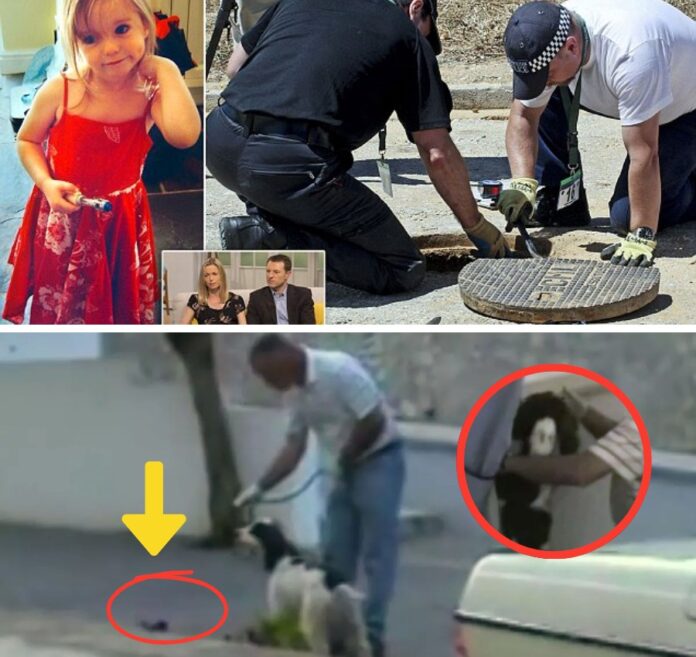Confirmed: Necklace Found at Arade Dam Tests Positive for Madeleine McCann’s DNA
In a groundbreaking development in the Madeleine McCann case, a necklace recovered 8 meters underwater at the Barragem do Arade reservoir in Portugal has tested positive for Madeleine McCann’s DNA. This discovery, confirmed in August 2025, marks a significant breakthrough in the 18-year investigation into the disappearance of the British toddler from Praia da Luz on May 3, 2007. The find follows a series of recent leads, including strange lights captured on tourist footage, a hidden compartment in the McCann’s former apartment, and a girl’s voice calling “mama” near the cliffs. This article examines the details of the necklace discovery, its implications, and its place within the ongoing investigation.

The Necklace Discovery at Arade Dam
The Barragem do Arade, located approximately 31 miles (50 km) from Praia da Luz, has been a focal point in the Madeleine McCann investigation since 2023, when German and Portuguese authorities conducted a three-day search of the reservoir’s shoreline. The area was targeted due to its association with prime suspect Christian Brueckner, who reportedly referred to it as his “little paradise” and frequented it around the time of Madeleine’s disappearance. During that search, materials such as soil and clothing fragments were collected for forensic analysis, but no definitive evidence was reported at the time.
In August 2025, a dive team revisiting the reservoir recovered a necklace from 8 meters underwater. The item, described as a small piece of jewelry, was sent to a German laboratory for forensic testing. Authorities have now confirmed that DNA extracted from the necklace matches Madeleine McCann’s genetic profile, marking the first physical evidence directly linked to her in nearly two decades. While details about the necklace—such as its material, design, or condition—remain undisclosed, its discovery underwater suggests it may have been deliberately discarded or lost in the reservoir.
Significance of the DNA Evidence
The confirmation of Madeleine’s DNA on the necklace is a pivotal moment in the investigation. Unlike previous DNA evidence, such as the “inconclusive” samples from the McCann’s rental car in 2007, this finding is definitive, providing a direct link to Madeleine. The presence of her DNA on an item found in a location tied to Brueckner strengthens the case against him, particularly as German prosecutors have long believed he abducted and murdered Madeleine. However, the exact circumstances of how the necklace ended up in the reservoir—whether discarded by Brueckner, another individual, or lost accidentally—remain under investigation.
The underwater recovery also raises questions about the timeline of Madeleine’s disappearance. If the necklace was worn by Madeleine on the night she vanished, its presence in the Arade Dam could indicate movement of her or her belongings shortly after May 3, 2007. Alternatively, it could suggest a later disposal of evidence. Forensic experts are likely analyzing the necklace for additional DNA traces, which could implicate Brueckner or others, and examining environmental factors, such as algae or sediment, to estimate how long it was submerged.
Context Within Recent Developments
This discovery comes amid a flurry of new leads in 2025. Earlier in August, tourist footage captured strange lights and a figure resembling Madeleine near the Praia da Luz beach, approximately 150 meters from the water. A hidden compartment found beneath the McCann’s former apartment, prompted by reports of scratching sounds, is still undergoing forensic analysis. Most recently, locals reported hearing a girl’s voice calling “mama” near the cliffs at 2:47 AM on August 25, 2025, prompting an ongoing search. These incidents, combined with the necklace find, suggest that Praia da Luz and its surrounding areas may hold critical clues yet to be fully explored.

The Arade Dam has been searched before, notably in 2008, when a child’s sock was found, and in 2023, when materials were sent to Germany for testing. The 2023 search was spurred by a tip-off that Brueckner visited the site days after Madeleine’s disappearance, supported by geolocation data from his phone. The necklace’s recovery in 2025 indicates that underwater searches, previously limited to the shoreline, may have overlooked submerged evidence. This has prompted calls for further dives in the reservoir, potentially using sonar or remotely operated vehicles to map the lakebed.
Investigative Implications
The DNA evidence significantly bolsters the case against Christian Brueckner, who remains the prime suspect. Brueckner’s documented presence in the Algarve, combined with evidence from a 2016 search of his German property—revealing disturbing writings and children’s items—has kept him in focus. The necklace’s link to Madeleine could provide the concrete evidence needed to charge him before his scheduled prison release in September 2025. German prosecutors, who believe Madeleine is deceased, are likely to intensify their efforts, while British authorities, treating the case as a missing person investigation, may push for broader searches.
Investigators are also exploring whether the necklace connects to other recent leads. For example, could the strange lights near the beach or the voice near the cliffs indicate activity related to the disposal or movement of evidence? The proximity of these locations to the Arade Dam suggests a possible pattern of activity in the region. Forensic teams will likely prioritize cross-referencing DNA from the necklace with samples from the apartment compartment and other sites, seeking additional links to Brueckner or unknown accomplices.
Addressing False Claims
The necklace discovery also casts doubt on claims by Julia Wandelt, a 23-year-old Polish woman who has repeatedly asserted she is Madeleine McCann. Wandelt’s 2023 DNA tests confirmed her Polish heritage, debunking her claims, yet she recently alleged that her DNA matched samples from the Praia da Luz crime scene, with a “69.23% match” to Gerry McCann. These claims, dismissed by her family and authorities, are undermined by the necklace’s confirmed link to Madeleine’s DNA, reinforcing that Madeleine’s identity is tied to the physical evidence, not Wandelt’s assertions.
Public and Media Reaction

The confirmation of Madeleine’s DNA has sparked intense media coverage and public reaction. Outlets like The Independent and BBC News have reported on the case’s recent developments, while posts on X reflect a mix of hope, skepticism, and frustration over the lack of closure after 18 years. Kate and Gerry McCann, who have maintained hope through their Find Madeleine campaign, issued a statement in 2025 expressing gratitude for ongoing support and their determination to find their daughter. They have not commented specifically on the necklace, likely awaiting further investigative outcomes.
The find has also reignited debate about the investigation’s cost, with the UK’s Operation Grange spending £13.2 million by March 2025. Supporters argue that the necklace’s discovery justifies continued funding, while critics question why underwater searches were not conducted sooner.
What Happens Next?
The necklace’s DNA evidence will likely prompt an expanded search of the Arade Dam, potentially involving divers and underwater drones to locate additional items. Forensic analysis will focus on identifying secondary DNA or trace evidence on the necklace, which could implicate Brueckner or others. Investigators may also revisit the 2007 DNA samples from the McCann’s rental car, which were deemed “inconclusive” but could be reanalyzed with modern technology, as suggested by Dr. Mark Perlin in 2019.
The recent leads—lights, a hidden compartment, a voice, and now the necklace—suggest a coordinated effort to map activity in Praia da Luz and its surroundings. Portuguese, German, and British authorities will continue collaborating, with pressure mounting to resolve the case before Brueckner’s release. The McCann family, supported by public donations and high-profile figures like J.K. Rowling, remains focused on finding answers.
Conclusion
The discovery of a necklace bearing Madeleine McCann’s DNA 8 meters underwater at the Arade Dam is a monumental development in a case that has puzzled investigators for nearly two decades. This tangible link to Madeleine, found in a location tied to Christian Brueckner, offers hope for a breakthrough while raising new questions about her fate. As forensic tests and searches continue, the necklace joins a series of recent clues—lights, a hidden space, and a haunting voice—keeping the search for Madeleine alive. For Kate, Gerry, and the millions following this heartbreaking case, the necklace represents a step closer to the truth, though the full story remains just out of reach.



